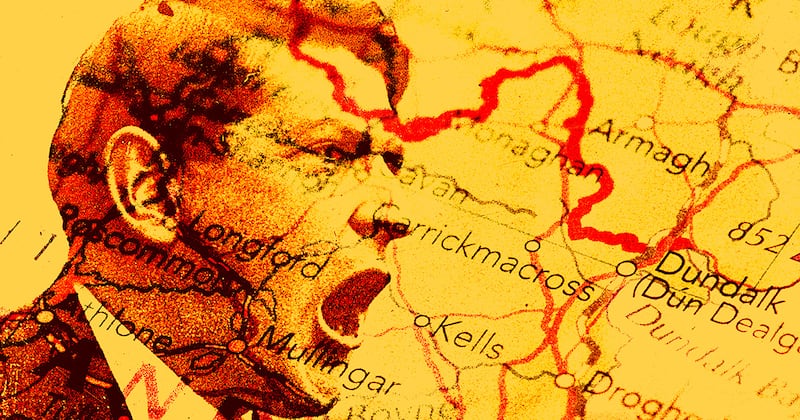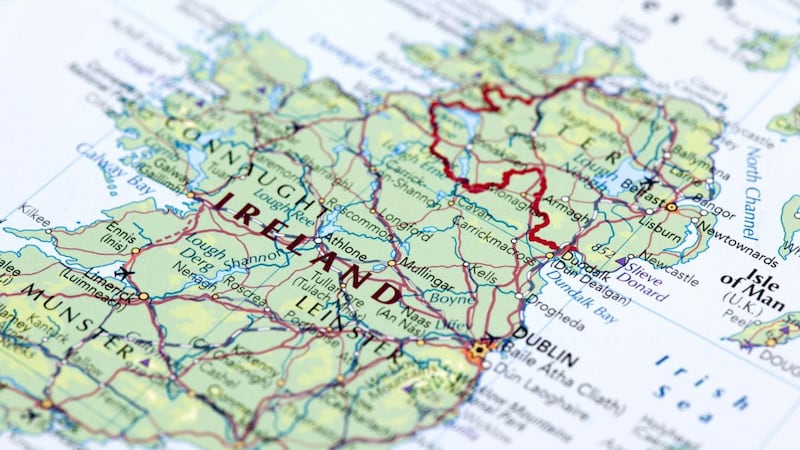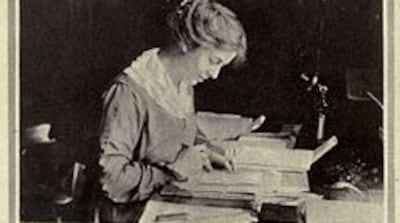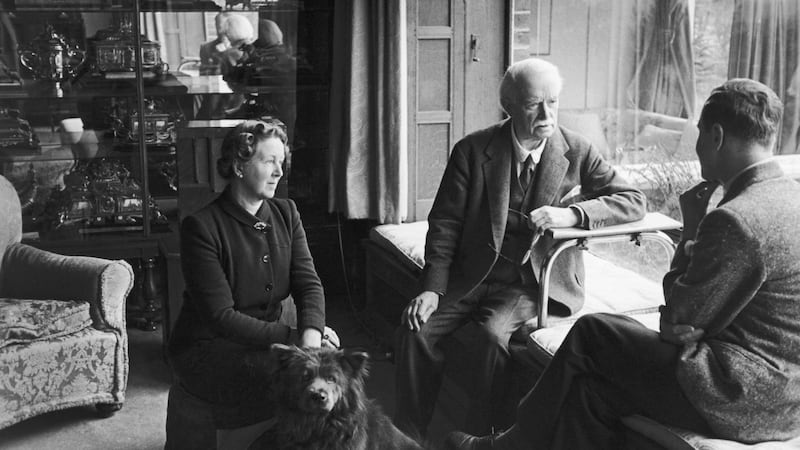In mid-July 1921 just days after the Truce had been agreed in the War of Independence, Éamon de Valera led a Sinn Féin delegation to London for talks with David Lloyd George. The leader of a brittle and discontented Liberal-Conservative government, Lloyd George was busy, tired and weakened by many extraneous factors. He had conspirators within his own cabinet. It was even possible that Irish policy might be used to displace him. Yet he was embarking on negotiations which would result within five months in the Anglo-Irish Treaty of December 1921 which the British would deem a success since it promised to take the Irish question out of British domestic politics.
Duplicity came naturally to Lloyd George. Time and again he astounded those with whom he was negotiating with his capacity for rapid changes of tack. The astounded included his adversaries and sometimes those negotiating alongside him. Not for nothing was he known as the Welsh wizard.
Frances Stevenson (1888-1972) was secretary, mistress and soulmate to Lloyd George: she was an accomplished diarist whose own private papers – alongside his voluminous archive of which she was initiator and custodian – augmented the official British records of his premiership.



She had first met Lloyd George in 1911 when she was 22 and employed as governess to his youngest daughter Megan; by 1913 she had accepted his invitation – on his terms – to become his secretary. His terms included a sexual relationship. Thereafter, until his wife’s death in 1941, Lloyd George effectively lived the life of a bigamist. It was only after his wife’s death that he – at the age of 80 – married Frances.
She had been made a CBE as early as 1918 in the New Year honours list. She accompanied Lloyd George to the Paris Peace Conference in 1919 and had written a series of articles for the Sunday Times on the main delegates under the pseudonym, “One who knows them”.
She was a perceptive diarist, methodically recording her impressions of Lloyd George’s political work. But she was also an intermittent diarist and we are fortunate that she was writing up her diary during the Lloyd George-de Valera summits of July 1921.
Laced with intimate indications of mood and gossip, they include the sort of detail which does not find expression in the formal minutes of such encounters. The Stevenson diary is the surest indication we have of how Lloyd George read the opening "talks about talks" phase of this vital period in British-Irish relations. It tallies with such official records as are available and it is also consistent with Lloyd George's regular reports to George V about progress – or lack of it – in his talks with de Valera.
On July 12th, 1921, Stevenson noted that Lloyd George was “going down to Chequers tomorrow” to have a conference with Austen Chamberlain, AJ Balfour and some others in advance of the start of these talks with the Sinn Féin delegates. Lloyd George liked to involve his critics and potential rivals in the formulation of any policy process: if there were to be quicksands in these negotiations, Lloyd George did not want to be alone.

On July 13th, Stevenson wrote that Lloyd George appreciated the “extraordinary volte-face” that had happened during recent weeks. “It was not so very long ago that he was politically in deep waters, and in the trough of the wave.” But more recently he was “riding up to the crest of the waves, and a very steep and sudden rise, too”.
Later she recorded that Lloyd George had telephoned from Chequers to say that de Valera had asked to see him alone, chalking this up as “a great score” for himself, since the Irish and others had been saying that he was “not to be trusted”. Incidentally, the British official minutes of this informal conversation at Chequers indicate that it was a tentative suggestion from de Valera that the two leaders should first meet alone.
Why do you insist upon Republic? Saorstat is good enough!
South African prime minister Jan Smuts was in London for the Imperial Conference and had become a player in Anglo-Irish relations. He was interested in Ireland, hoped that his South African experience could prove useful and had crossed to Dublin to meet Sinn Féin leaders in advance of the Truce. He had travelled with Lloyd George's knowledge but without any formal role: this was not quite believed in Dublin. De Valera, however, was impressed by Smuts who did not reciprocate: he reckoned de Valera was living in a world of "dreams, visions and shadows".
Smuts, invited by Lloyd George to attend the Chequers strategic meeting, told the British ministers that he had advised de Valera that “the best plan” would be for an initial private meeting. He characterised the Irish negotiators as “totally inexperienced” and in a “state of extreme nervousness about negotiating with so distinguished a statesman” as Lloyd George.
“The first object was to remove these not unnatural apprehensions and to establish a good atmosphere in which to carry out the more formal conferences. He himself felt that the best way of achieving this would be for Mr Lloyd George to see Mr de Valera with the least possible formality and to discuss the matter very frankly. It would be desirable for the Prime Minister to allow Mr de Valera to talk very freely: in fact, to give plenty of tether.”
On July 14th, Lloyd George met de Valera for the first time. Stevenson recorded the scene in Downing Street after de Valera had “just gone”, having been with Lloyd George for “nearly three hours”. She noted that she had never seen Lloyd George “so excited” as he had been before de Valera had arrived, at 4.30pm. “He kept walking in and out of my room, and I could see he was working out the best way of dealing with DeV. As I told him afterwards, he was bringing up all his guns! He had a big map of the British Empire hung up on the wall in the Cabinet room, with its great blotches of red all over it. This was to impress DeV.”
In fact, Lloyd George told her that his aim was to emphasise to de Valera the greatness of the British empire, and "to get him to recognise it, and the King". And she records the direct speech which Lloyd George had used, characterising the empire as "a sisterhood of nations – the greatest in the world. Look at this table: There sits Africa – English and Boer; there sits Canada – French, Scotch and English; there sits Australia, representing many races – even Maoris [sic]; there sits India; here sit the representatives of England, Scotland and Wales; all we ask you to do is to take your place in this sisterhood of free nations. It is an invitation, Mr De Valera: we invite you here."
Incidentally, historian Nicholas Mansergh has noted that de Valera's own recollections, some 35 years after this initial encounter with Lloyd George, "tallied closely" with Stevenson's contemporaneous record.

Stevenson also recorded the complaint from Lloyd George that in these discussions, it had been “very difficult to keep to the point” as de Valera had “kept on going off at a tangent, and talking in formulas and refusing to face facts”, adding that whenever de Valera “appeared to be warming, he suddenly drew back as if frightened and timid”. Lloyd George also characterised him as “the man with the most limited vocabulary that he has ever met!”
Stevenson also attributed to Lloyd George some direct threats which had riled de Valera. She quotes Lloyd George as saying: “Terrible as events have been in Ireland, it is nothing to what they will be if we fail to come to an agreement.”
Lloyd George had instanced recent military successes which had made it possible for Britain “to withdraw our troops from Mesopotamia and Germany and other parts of the world”. Lloyd George now hesitated to think “of the horror if war breaks out again in Ireland”. At this, de Valera had got “very excited”, complaining that this was “a threat of force – of coercion”. Lloyd George responded that he was “simply forecasting what will inevitably happen if these conversations fail, and if you refuse our invitation to join us”.
Yet Stevenson ended this diary entry with optimism, noting that both leaders “seemed to get on well on the whole”.
She added that all British information suggested that Sinn Féin was “genuinely in earnest” and the fact that outrages had ceased reassured them that de Valera had authority.
The two leaders met again on the following day Friday, July 15th, but it was Monday before Stevenson made her diary entry. She wrote that Lloyd George’s impression was that de Valera “had evidently been afraid he had gone too far” at their first meeting and was now “bent on impressing on D [David Lloyd George] the idea that he had proposed nothing and consented to nothing”.
She noted that de Valera had "insisted that what the people of Ireland wanted was a republic", and had asked Lloyd George "if the name of republic could not be conceded at any rate". Lloyd George had replied that that "was just what they could not have – that the people of this country would not tolerate it after all that had happened".

Lloyd George had then mooted that “there must be some other word”. And since republic was not an Irish word, he asked what was the word for republic in Irish? “Poblacht” is recorded as de Valera’s reply: to which Lloyd George responded that this merely meant “people”, asking was there not another word? She records “Saorstat” as de Valera’s response. “Very well”, said Lloyd George: “Why do you insist upon Republic? Saorstat is good enough!” To this riposte Stevenson notes that “for the first time DeV simply roared with laughter”.
She considered that the trouble was “simply going to be Ulster”. Lloyd George had already drafted a summary of terms which he proposed sending to de Valera on Wednesday night [July 20th], and to which de Valera would reply on Thursday.
She noted that Lloyd George had delayed giving the draft terms to de Valera “as he thought the time was not ripe”. Stevenson notes that Smuts had seen de Valera “and impressed upon him the great difficulty with Ulster” but she recorded that Smuts was not optimistic as de Valera did not really appreciate that Ulster provided the Lloyd George government with any “real difficulty”, believing that they were “just using Ulster to frighten him”.
She also records that Lloyd George had seen Sir James Craig, finding him "quite obstinate", as was his cabinet who, for their part, believed that Lloyd George was "trying to use Sinn Féin to persuade them to concede something".
She summarised: “So the position is tightening a little, and it looks very much as though Ulster would again prove a stumbling block in the settlement.” Lloyd George remained “a little worried about it”, but she believed that “in his heart of hearts” he was “bent on settling it”; but did not like to appear too confident “in case anything may happen”. And she gives due weight to the brittle nature of his coalition government. There were, she allowed, “lots of people who don’t want a settlement and who would be very glad to see him fail”.
The two leaders were to have their final meeting on Thursday, July 21st. On the eve of that meeting she recorded that matters were “more hopeful with regard to Ireland today”. The previous night they had “looked black” with de Valera taking exception to a statement made by Craig in which he had presumed himself to be Northern Ireland’s spokesman with de Valera being confined to representing Ireland south of the new border.
De Valera now warned that if Lloyd George shared that view “it was not worthwhile continuing the conversations”. Stevenson noted that Lloyd George had replied with “a very curt note saying that he was no more responsible for Craig’s views than he was for the statement De Valera had made to which Craig’s statement was a reply. De Valera did not answer, but did not publish the letters, and Smuts saw him this morning and reports that he is in a better state of mind and not nearly so obstinate”.
She concluded this diary entry noting that Lloyd George would forward the terms that evening, meet de Valera on the following “critical day” and that Lloyd George was “getting very excited about it”.
If he settles Ireland, he is prepared to go out of office: he can go no higher
The two leaders met for the final time on July 21st which she records as “a not too satisfactory interview”. From the first moment when she had seen Lloyd George after the session, she recognised him as “very depressed” and believed the meeting “had been a failure”.
De Valera had not even “taken the terms away with him – but we now find this was a mistake, as he has since sent for them – How Irish!” After de Valera had read the terms, he told Lloyd George he could not advise his people to accept them. “Very well, Mr. DeV.”, was Lloyd George’s answer, “then there is only one thing more left for us to discuss.” And when de Valera asked what that was, Lloyd George replied: “The time for the truce to come to an end.” Lloyd George informed her that at this de Valera had gone “perfectly white, and had great difficulty in controlling his agitation”. He then said that at any rate “he would put them before his people” and report back.
Although Lloyd George thought the meeting “pretty hopeless” at the time, she wrote that she was “perfectly convinced DeV. was only bluffing” and she was confirmed in this view by anything she had heard since.
“We hear that they are very pleased with the terms, that they are more than they ever hoped to get, but that of course it is only policy to refuse at first in the hope that they may get even more. They have returned to Ireland today and meantime the Irish papers are behaving very well, and it is evident that the bulk of Irish opinion wants peace.”
She records Lloyd George as saying that were Sinn Féin to reject the terms there was “only one thing to be done – to reconquer Ireland”. She records Balfour as having “squirmed at the Cabinet when the terms were discussed preliminary to sending them to DeV. They were so contrary to all the views the old man had ever held on Ireland.” But she concluded that Balfour had given in “gracefully”, and that Lloyd George had succeeded in having “a unanimous Cabinet, which was a great achievement”.
It is also noteworthy that in her diary entry for July 20th she had recorded Lloyd George as confiding that “if he settles Ireland, he is prepared to go out of office”. He was “quite serious about it” as he believed that were he to settle Ireland, “he can go no higher, and the rest would do him good”.
Dr John Bowman is an historian and broadcaster. He is author of De Valera and the Ulster Question: 1917-1973 published by Oxford University Press 1982. His latest book is Ireland: the Autobiography published by Penguin















